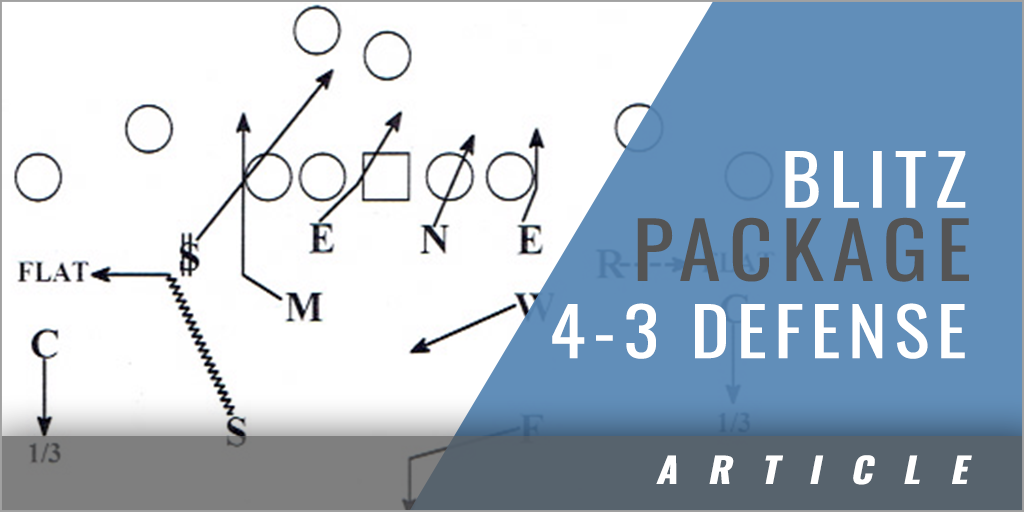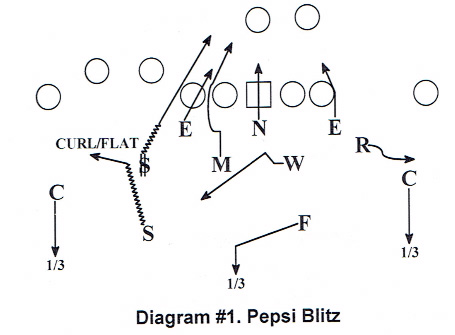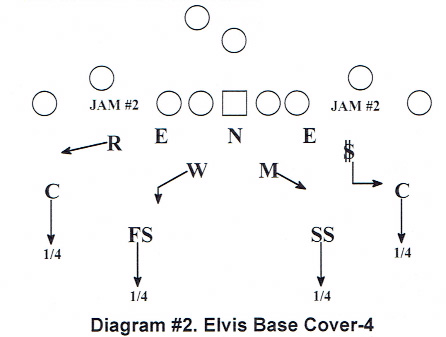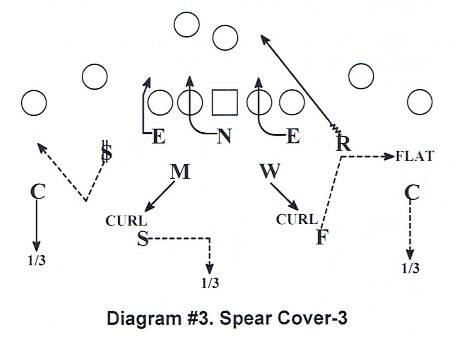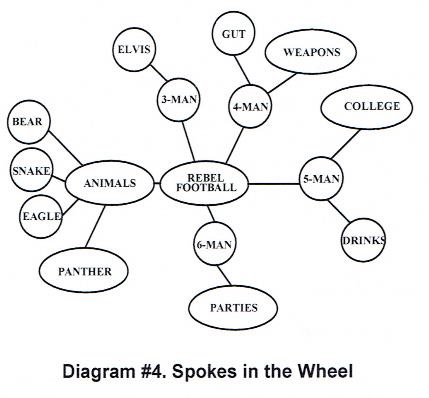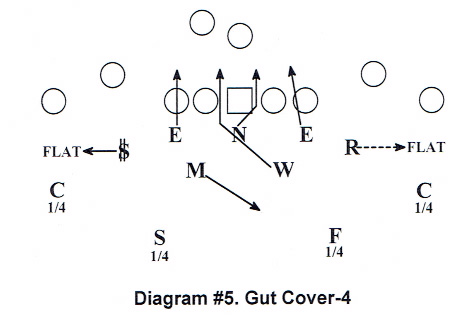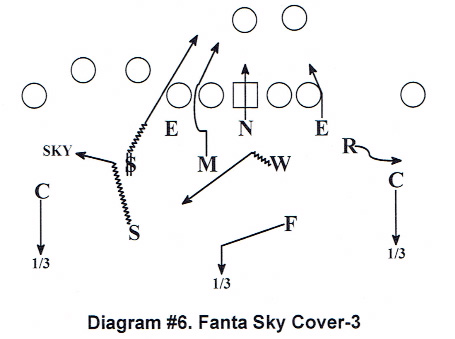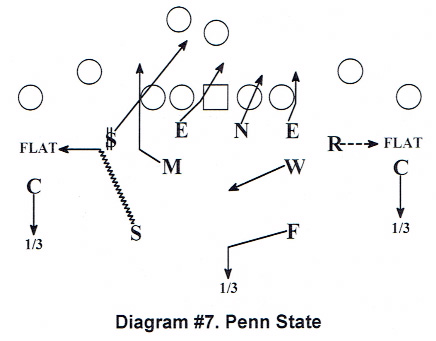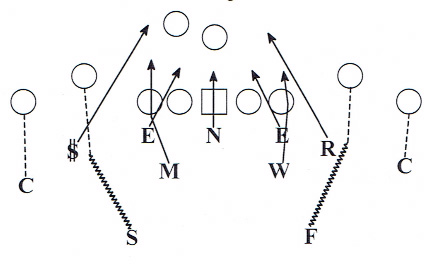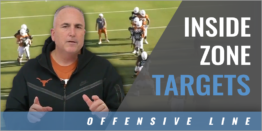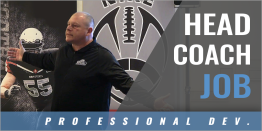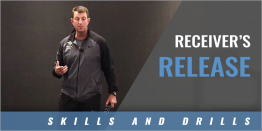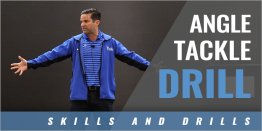| By: David Younger
Originally Published in: 2015 Coach of the Year Clinic Notes - by Earl Browning Provided by: Nike Coach of the Year Thank you very much. I am excited to be here today. Jeff Louber and I have been around South Albany many times together. He has always been a 4-3 guy and I was always a 4-4 coach. He is going to help me out today with this presentation. When we first came to South Albany in 2013, we were still running the 4-4 defense. We changed to the 3-4 defense in 2014 and it made a huge difference. We are an undersized football team without many big body players. We do not have many defensive linemen in our program. The kids that are coming out for the team want to play defensive back or wide receiver. We are a spread, no-huddle offense. They want to throw the ball, catch the ball, or make picks on defense. We needed to find a way to create pressure with our undersized defensive linemen. Our nose tackle this year was a wrestler who weighed maybe 160-pounds. However, he was the type of player we wanted to play that position. He was a scrapper, liked to get his hands on people, and did not mind getting a bloody nose. We do not ask our nose guard to play two gaps. He is going to move and slant and create angles for our linebacker to get pressure on the quarterback. I am going to show you why we went to the 3-4 defense. We call this a "Pepsi" blitz. (Diagram #1)
This is a five-man pressure blitz. The right outside linebacker comes off the edge with a contain blitz. The Mike linebacker blitzes the B-gap. We did not slant the defensive line on this play but we normally do. In the secondary, we roll the strong safety down into the strong flat. He is a curl/flat defender. Even without slanting anyone in the line, we can get to the quarterback with the two-linebacker blitz. When you run a blitz, you must keep the disguise. If you move too early, the offense will read what you are doing. When you send the Mike linebacker, the Will linebacker has to replace the Mike linebacker and cover the strong side seam route. When we took the job we knew there were some issues we would have to solve. We knew we had to make a change. We were not very good and we needed to have something that could level the playing field for us. WHY THE 3-4? 2013 Stats/4-4 • Gave up 275 points • 30.5 points per game • 0 sacks • 11 turnovers • Leading tackler - a free safety 2014 Stats/3-4 • Gave up 200 points • 22.2 points per game • 32 sacks • 29 turnovers • Leading tackler - Mike LBer After one year in the defense, we made improvement in our points given up, but we still give up too many. However, we went from no sacks to 32 sacks, and from 11 turnovers to 29. This was a big improvements for us. The thing I liked about the improvements was our leading tackler was our Mike linebacker and not a strong safety. In 2013, we started six sophomores on defense. They got better in the 2014 season and got a lot stronger in the weight room. Defensive Philosophy • Our philosophy is to be a very aggressive defense with movement and multiplicity form our base. We want PRESSURE through DIVERSITY • 4 ingredients for great defense º Attitude º Will º Leadership º Reckless Abandon When we talk about pressure through diversity were are talking about attacking the quarterback with multiple defenders. We are so undersized with our players that we had to develop an attitude. We want our players to have great will power and never give up. If they end up on the ground, we want them to get up and get to the ball. To develop the other ingredients you must have players to be great leaders. The goal of every player should be to play with reckless abandon. It is amazing how good high school quarterbacks have become at reading defenses in the pre-snap read. We believe the 3-4 can combat player advancement with four things. • Show the same pre-snap look every time • Can threaten with any of the linebackers • Gives the ability to use smaller, quicker players on the defensive line who can slant • Allows uncertainty in a 16-17 year old decision making skills at the pre-snap read, which allows our play calling to be less predictable We do not want the quarterback to be able to know where he is going to throw the ball before he snaps it. We are not good with the disguise yet, but we have improved at not tipping what we are going to do. When the quarterback comes to the line of scrimmage, he will see what we call "Elvis Base Cover-4." (Diagram #2) The nose-guard is head up the center. The defensive ends align in a 4 or 4i-technique on the offensive tackles. The Mike and Will linebackers are over the guards at 5 yards off the line of scrimmage. The outside linebackers are the Stinger and Rover. They align on the number-2 receivers in the formation about three yards outside and three yards deep. They jam and reroute the number-2 receivers and become flat defenders.
The corners are seven yards off the line of scrimmage aligned on the wide receivers. The safeties are 10 yards deep. Two years ago we did not celebrate a big play. We now have players congratulating players and celebrating when they do something good. We wanted to make sure our players knew football was fun and it is okay to celebrate. In practice, we practice celebrations. We think that projects positive energy. The "Spear" blitz is an outside linebacker blitz. (Diagram #3) If the blitz comes from the right, the defensive line slants to the left. The free safety rolls down and replaces the Rover linebacker on the blitz. He becomes the flat defender and we play cover-3 over the top.
We want the Rover linebacker to time his blitz so he hits the line of scrimmage at the snap of the ball. He comes hard off the offensive tackles outside hip. He aligns outside with inside leverage on the number-2 receiver three yards off the ball. We run this stunt to the side of a star receiver. We know the quarterback will look for the star receiver and may not see the safety rolling down. He may see the blitz and throw hot to the safety. It is a four-man pressure. When the Rover moves. the free safety starts down. Our defensive ends are basketball type athletes. They are 185 and 200-pounds. They are quick and it helps us create angles with our stunts. We play cover-3 in the secondary. We want all four of our defensive backs to be interchangeable. We want them to be able to play all four positions in the secondary. We knew when we came into this job that it would be a difficult transition. We had to come up with a way for our players to buy into what we were selling. We came up with what our vision was for the program and came up with our core values. If you get into this situation where you know it is going to be a tough climb, create a vision for the program. We came up with these core values and they are posted throughout our locker room. Core Values • Honesty • Make good judgments • Compete everyday • Be accountable • Project positive energy • LEAVE NO DOUBT We believe that "Leave No Doubt" encompasses our entire football team. We want to make sure our players leave no doubt in their personal life. if they go to church make that the first thing in their life. The family is number two. They want to leave no doubt in the classroom. They must do everything they can to leave no doubt about everything in their life. That carries over to the football field. Leave no doubt is the most important rule for our football program and it has worked well. I am going to turn the program over to Jeff. He was at West Albany and was a big part of their championship there. JEFF TOUBER This is what I want you to take away from this presentation. • At least one thing • Find something that fits your program • This is a process • Do not try to implement all aspects in one year • KISS • Do not over think at this level • Make your blitzes count • Do not roll the dice • Choose a few blitz packages to focus on each week • Do not adopt a PAC-12 defensive play book • Think about what you should do and not about what we could do • Build confidence and consistency I started coaching in 2004 at West Albany. I coached freshman football for a few years and moved on to the varsity squad as linebacker coach. Jim Phillips was the head coach at that time. If you know him, he is extremely old school. I learned from an old school coach. Everything we call had a ton of verbiage to it and I thought that was the way to do things. What I have learned over the years is we need to keep it simple. Do not over-think what you are doing and when you do blitz make it count. I went to some of the University of Oregon clinics. They have it figured out as to how to simplify things. The way they do it I bought into. Most of the stuff I do is based on what Oregon does. When you keep it simple, the players are confident and play with consistency. If they are confident they can go hard. If they know what they are doing they do not worry about it. When we call the defense we have one word that tells them what to do. The word could be "Pepsi." That tells the defensive line to slant. The outside linebacker comes on a contain blitz off the edge. The Mike linebacker runs a blitz through the first available gap to the contain blitz side. The safety rolls down to replace the outside linebacker, and plays three deep. That was what I got from Oregon. When we set up the defense we look for certain types of personnel. PERSONNEL LINE • Nose - Wrestler type with great hands, two gaps at times, can slant, no slugs • Strong End - Big stud, needs to be as quick as the nose • Weak End - Utility lineman able to play 2i, 2, 4i, 4, or 4o • Strong Outside Linebacker - Tough basketball player type, can take on a tight end and play SCIF (seam, curl, in, flat) needs to get his hands on #2 mirror and hand off • Weak Outside Linebacker - Wrestler Type - May need to get hands on #2, and cover. Must take on pulling guard and love it • Inside Linebacker - You know them • Strong safety - Best secondary player • Weak safety - Ball hawk • Corners - Track kids When I talk about the nose, I do not want a slug. That is a big player that cannot move. The strong outside linebacker is the basketball player type. The only reason he is on the basketball team is because he is a bruiser. He does all the tough jobs on the court. The strong safety has to run the alleys and be the support player on the run. He also has to cover people. This next item are the spokes of our defense. (Diagram #4) This is the one word communication we use. It is almost like a big wheel with spokes on the wheel. When you consider the blitz scheme, the first thing you want to know is how many people do I want to send. If the answer is three, we have one choice and that is Elvis. If I want to send four, I have two packages for that. If I want to send five-men, I have two packages for that. Six-man pressure has only one package and it is "parties." The animal spoke is not a blitz packages but are personnel groups.
In the animal spoke we have "Bear", which is the 46 package. Snake is a 4-3 look. Eagle is the 3-technique alignments in the eagle front. Panther is the 4-4 look. When you decide to blitz, the first thing is how many in the blitz. After you decide the number you must know where you want it to come from. That comes from the scouting report and game plan. If a team has a star player that catches most of their balls, we bring the blitz form his side every time. We do not want the quarterback to sit and stare at him until he gets open. We want the blitz to that side in his face. You must know your limits as a defensive team. There is so much you can do. The question is should you do it. Do not ask players to do things they cannot do or be successful at doing. Where do you want to send the pressure from? • Passing strength • TE/running strength • Field • Boundary • Toward the star • Up the middle • Running back side We make our calls just like Oregon. • Ringo/Lucky is the strength • Show a picture or sign • Right or Left is the blitz, the inside linebacker calls right or left and the defensive line slants opposite the call • The exotic (we call them animals) have their own rules If the formation is a trips right formation, we make our call off the alignment. If the call is a beverage call, we have a sign with four beverages on it. If the hot call is "Pepsi", we know what the blitz is. Pepsi starts with a P, which stands for passing strength. The blitz is coming from the passing strength side, which is the right. The Stinger outside linebacker and the Mike inside linebacker are coming on the blitz. The defensive line is going to slant away from the formation call. The linebacker gives a "right, right, and right" call and the defensive line knows they slant left. In the passing spoke, the five-man pressure has drinks and colleges linked with those pressures. If the call was a "college" call, that would be a different blitz path than the "drink" blitz. When the defensive line slants, they take a hard horizontal step in the direction they are going to get vertical as quickly as they can. They are not slanting into a gap. They slant into the offensive blocker. They are going through his facemask. We want them to take the horizontal step and get vertical as quickly as possible. If we want to bring three-man pressure, we call Elvis. Elvis is a base cover-4 defense. We are rushing with three, dropping four underneath and playing four deep. Since we are rushing with three defenders. you cannot play a man concept. You cannot expect a high school player to cover man-to-man for the time it takes three rushers to get to the passer. The next spoke is the four-man pressure system. Every time we run this four-man pressure system. we will be in cover-3. This is our weapon spoke. Weapons • Pistol (passing strength) • Tanks (tight end or running strength) • War - weak side • Bomb - Boundary • Fire - Field • Spear - Star You can make up your own categories because the category does not matter, it is what the word starts with. If you wanted to use cars, the P-word could be Pontiac. If the formation is a 2 X 2 and the blitz is 'pistol", the outside linebacker to the passing strength side is going to blitz off the edge. The defensive line slants away from the call and the strong safety rolls down to replace the outside linebacker. Another four-man pressure is a "gut" call. (Diagram #5)
This is an A-gap pressure. With this stunt we can play cover-4, 2, or 1. The nose slants into the weak side A-gap. The Will linebacker crosses behind the nose guard and blitzes the strong side A-gap. The next spoke is a 5-man pressure. I want to send three linemen, an outside linebacker, and an inside linebacker. In the 5-man pressure we have two different spokes. We have beverages and colleges. With this spoke we always run a cover-3 with a sky or cloud roll. Beverages • Fanta - Field • Pepsi - Passing strength • Tea - Tight end or running strength • Water - Weak side running game • Beer - Boundary • Squirt - Star player The blitz from the beverage is the outside linebacker running a contain blitz from the edge. (Diagram #6) The defensive line slants away from the blitz call. The Mike linebacker is coming on the blitz. He is finding the best path through the B-gap. As he runs his blitz, he reads the block of the offensive tackle. If the tackle is coming down inside, he avoids the B-gap and blitzes outside the offensive tackle. If the tackle is fanning outside, he comes inside the tackle in the B-gap. The defensive end slanting to the inside will cancel the block of the guard.
There is a difference between the beverages and the colleges. They are both five-man blitz packages but their blitz path is different. Colleges • Florida State - Field • Penn State - Passing strength • Texas - Tight end running strength • Wisconsin - Weak running side • Baylor - Boundary • Southern Oregon - Star On the college blitz, the outside linebacker is blitzing off the edge. (Diagram #7) However, he is not a contain blitzer, he is a spill blitzer. If it is a kick out or trap block, the outside linebacker spills the ball to the Mike linebacker coming outside of him. I love this against teams that run gap scheme powers, counters, and sprint the quarterbacks out. The defensive end moves into an Eagle technique on the guard and slants into the center. The nose is in a back side shade on the center and slants across the guards face to the B-gap. The backside end contains off the back side.
The last spoke is the six-man blitz. The key word for the six-man blitz is parties. We are throwing a party and inviting lots of people. Parties • BBQ - Double Weapon • Feast - Double Gut • Retire - Double Beverage • Graduation - Double College When we run the six-man package we play cover-0 or cover-1. (Diagram #8) This is a retirement party. We run double beverage stunts in the blitz. The defensive ends align in a 4i-alignment and slant inside. The nose plays straight over the center. The Rover and Stinger come off the edges in a contain blitz. The Will and Mike linebackers run their beverage stunt reading the tackle as they go. The Stinger is to the side of the running back. If the running back flares or runs a pattern, the Stinger peels off his blitz and takes the running back.
The secondary is locked in cover-0. The blitz has to get home in a hurry. You cannot expect high school players to cover a receiver for an extended length of time. If you want to stay around and talk, we are available. If you want to know more, send me an email and I will get back to you. I hope you can use at least one thing out of this presentation. Thanks for coming. |
